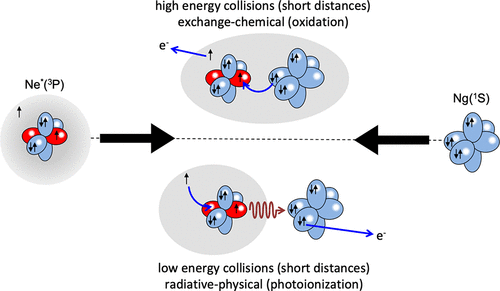当前位置:
X-MOL 学术
›
Acc. Chem. Res.
›
论文详情
Our official English website, www.x-mol.net, welcomes your feedback! (Note: you will need to create a separate account there.)
Quantum-State Controlled Reaction Channels in Chemi-ionization Processes: Radiative (Optical-Physical) and Exchange (Oxidative-Chemical) Mechanisms.
Accounts of Chemical Research ( IF 18.3 ) Pub Date : 2020-09-15 , DOI: 10.1021/acs.accounts.0c00371 Stefano Falcinelli 1 , James M Farrar 2 , Franco Vecchiocattivi 1 , Fernando Pirani 3, 4
Accounts of Chemical Research ( IF 18.3 ) Pub Date : 2020-09-15 , DOI: 10.1021/acs.accounts.0c00371 Stefano Falcinelli 1 , James M Farrar 2 , Franco Vecchiocattivi 1 , Fernando Pirani 3, 4
Affiliation

|
Most chemical processes are triggered by electron or charge transfer phenomena (CT). An important class of processes involving CT are chemi-ionization reactions. Such processes are very common in nature, involving neutral species in ground or excited electronic states with sufficient energy (X*) to yield ionic products, and are considered as the primary initial step in flames. They are characterized by pronounced electronic rearrangements that take place within the collisional complex (X···M)* formed by approaching reagents, as shown by the following scheme, where M is an atomic or molecular target: X* + M → (X···M)* → [(X+···M) ↔ (X···M+)]e− (X···M)+ + e– → final ions.
(X···M)+ + e– → final ions.
中文翻译:

化学电离过程中的量子态控制反应通道:辐射(光学-物理)和交换(氧化-化学)机理。
大多数化学过程是由电子或电荷转移现象(CT)触发的。一类涉及CT的重要过程是化学电离反应。这样的过程在自然界中非常普遍,涉及处于基态或激发电子态的中性物质,其具有足够的能量(X *)以产生离子产物,被认为是火焰的主要起始步骤。它们的特征是在接近试剂形成的碰撞配合物(X···M)*内发生明显的电子重排,如以下方案所示,其中M是原子或分子目标:X * + M→(X ···M)*→[(X + ···M)↔(X···M +)] e − (X···M)+ + e – →最终离子。
(X···M)+ + e – →最终离子。
更新日期:2020-10-21
 (X···M)+ + e– → final ions.
(X···M)+ + e– → final ions.
中文翻译:

化学电离过程中的量子态控制反应通道:辐射(光学-物理)和交换(氧化-化学)机理。
大多数化学过程是由电子或电荷转移现象(CT)触发的。一类涉及CT的重要过程是化学电离反应。这样的过程在自然界中非常普遍,涉及处于基态或激发电子态的中性物质,其具有足够的能量(X *)以产生离子产物,被认为是火焰的主要起始步骤。它们的特征是在接近试剂形成的碰撞配合物(X···M)*内发生明显的电子重排,如以下方案所示,其中M是原子或分子目标:X * + M→(X ···M)*→[(X + ···M)↔(X···M +)] e −
 (X···M)+ + e – →最终离子。
(X···M)+ + e – →最终离子。



























 京公网安备 11010802027423号
京公网安备 11010802027423号